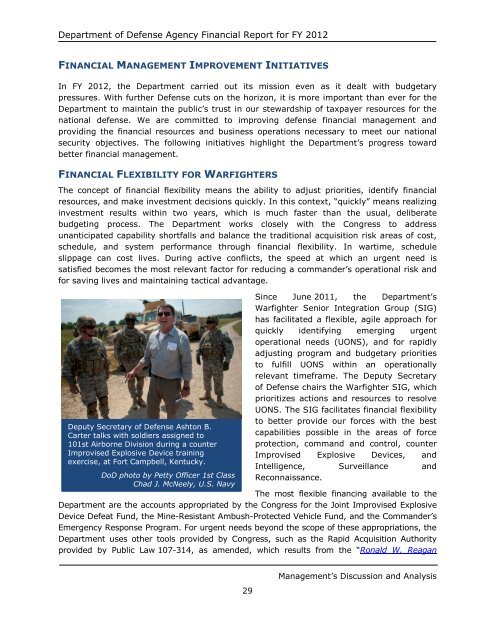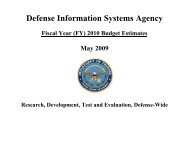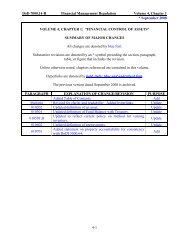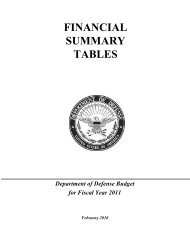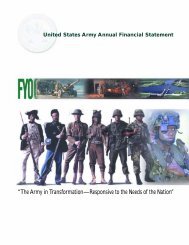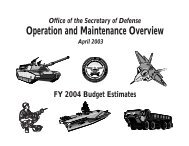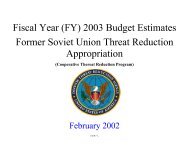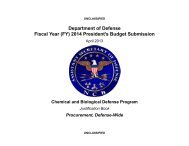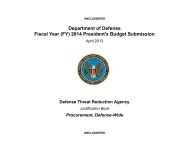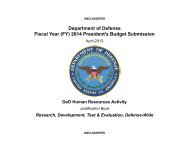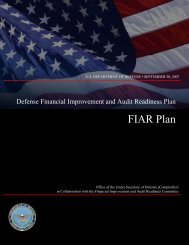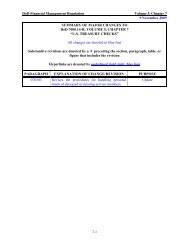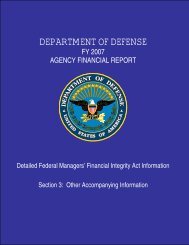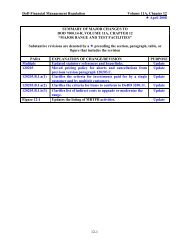department of defense agency financial report fiscal year 2012
department of defense agency financial report fiscal year 2012
department of defense agency financial report fiscal year 2012
You also want an ePaper? Increase the reach of your titles
YUMPU automatically turns print PDFs into web optimized ePapers that Google loves.
Department <strong>of</strong> Defense Agency Financial Report for FY <strong>2012</strong><br />
FINANCIAL MANAGEMENT IMPROVEMENT INITIATIVES<br />
In FY <strong>2012</strong>, the Department carried out its mission even as it dealt with budgetary<br />
pressures. With further Defense cuts on the horizon, it is more important than ever for the<br />
Department to maintain the public’s trust in our stewardship <strong>of</strong> taxpayer resources for the<br />
national <strong>defense</strong>. We are committed to improving <strong>defense</strong> <strong>financial</strong> management and<br />
providing the <strong>financial</strong> resources and business operations necessary to meet our national<br />
security objectives. The following initiatives highlight the Department’s progress toward<br />
better <strong>financial</strong> management.<br />
FINANCIAL FLEXIBILITY FOR WARFIGHTERS<br />
The concept <strong>of</strong> <strong>financial</strong> flexibility means the ability to adjust priorities, identify <strong>financial</strong><br />
resources, and make investment decisions quickly. In this context, “quickly” means realizing<br />
investment results within two <strong>year</strong>s, which is much faster than the usual, deliberate<br />
budgeting process. The Department works closely with the Congress to address<br />
unanticipated capability shortfalls and balance the traditional acquisition risk areas <strong>of</strong> cost,<br />
schedule, and system performance through <strong>financial</strong> flexibility. In wartime, schedule<br />
slippage can cost lives. During active conflicts, the speed at which an urgent need is<br />
satisfied becomes the most relevant factor for reducing a commander’s operational risk and<br />
for saving lives and maintaining tactical advantage.<br />
Deputy Secretary <strong>of</strong> Defense Ashton B.<br />
Carter talks with soldiers assigned to<br />
101st Airborne Division during a counter<br />
Improvised Explosive Device training<br />
exercise, at Fort Campbell, Kentucky.<br />
DoD photo by Petty Officer 1st Class<br />
Chad J. McNeely, U.S. Navy<br />
29<br />
Since June 2011, the Department’s<br />
Warfighter Senior Integration Group (SIG)<br />
has facilitated a flexible, agile approach for<br />
quickly identifying emerging urgent<br />
operational needs (UONS), and for rapidly<br />
adjusting program and budgetary priorities<br />
to fulfill UONS within an operationally<br />
relevant timeframe. The Deputy Secretary<br />
<strong>of</strong> Defense chairs the Warfighter SIG, which<br />
prioritizes actions and resources to resolve<br />
UONS. The SIG facilitates <strong>financial</strong> flexibility<br />
to better provide our forces with the best<br />
capabilities possible in the areas <strong>of</strong> force<br />
protection, command and control, counter<br />
Improvised Explosive Devices, and<br />
Intelligence, Surveillance and<br />
Reconnaissance.<br />
The most flexible financing available to the<br />
Department are the accounts appropriated by the Congress for the Joint Improvised Explosive<br />
Device Defeat Fund, the Mine-Resistant Ambush-Protected Vehicle Fund, and the Commander’s<br />
Emergency Response Program. For urgent needs beyond the scope <strong>of</strong> these appropriations, the<br />
Department uses other tools provided by Congress, such as the Rapid Acquisition Authority<br />
provided by Public Law 107-314, as amended, which results from the “Ronald W. Reagan<br />
Management’s Discussion and Analysis


